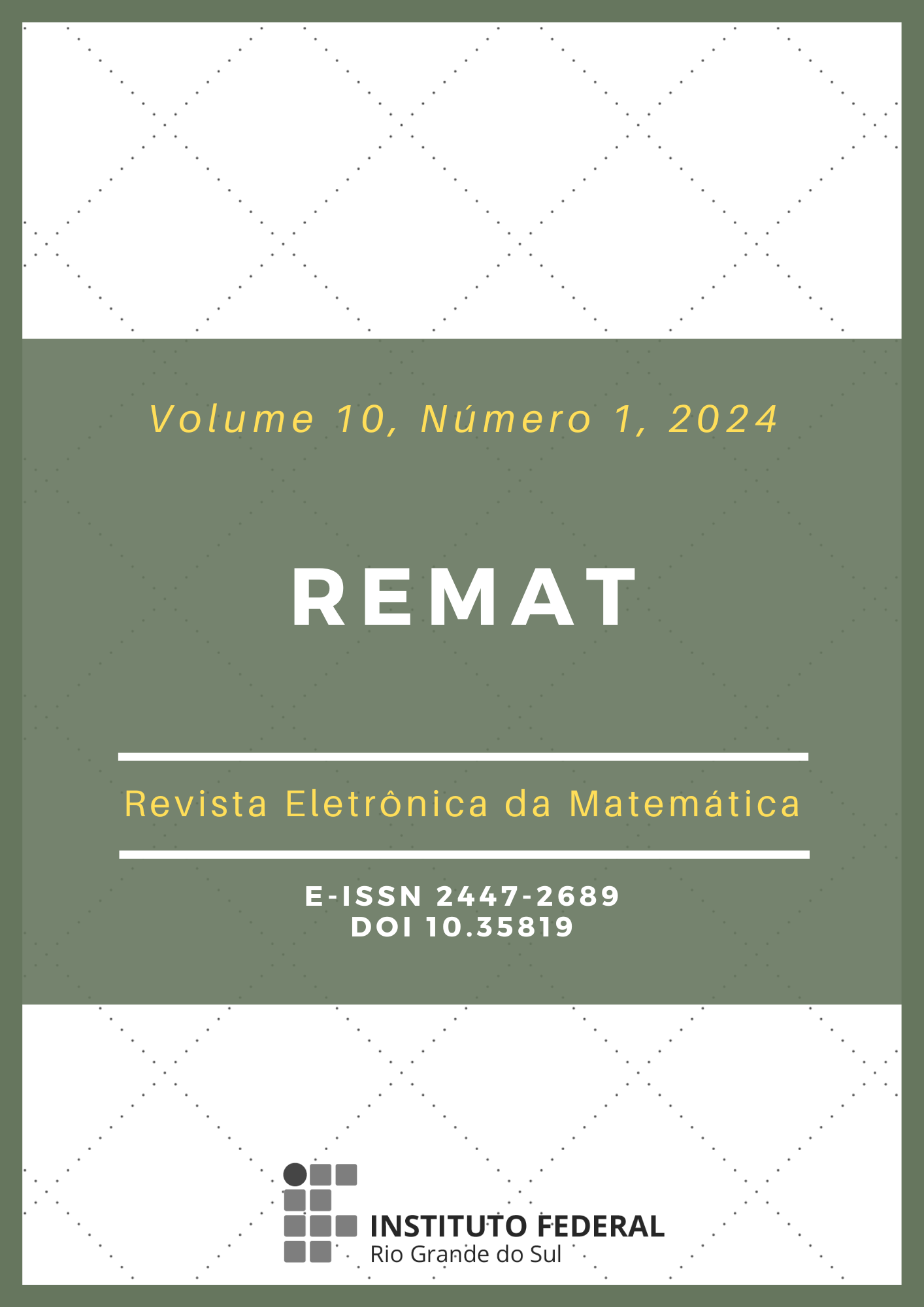Analysis of the Gompertz, Verhulst and Von Bertalanfly models for the linear growth of albino nile of Nile tilapia
DOI:
https://doi.org/10.35819/remat2024v10i1id6762Keywords:
mathematical modeling, tilapia, growth, Gompertz, Verhulst and Von BertalanffyAbstract
The objective of this work is to estimate the best mathematical model that represents the linear growth of albino male Nile tilapia. The models chosen for this article are by: Gompertz, Verhulst and Von Bertalanffy. The data are from an experiment previously conducted by the Rodolpho Von Ihering Ichthyological Research Center, which is located in the municipality of Pentecostes in Ceará. To analyze which model provides the best fit, the following evaluation criteria are used: Coefficient of Determination (R^2), Mean Square of the Residual (QMR), the Mean Percentage Error (EPM) and the Corrected AkaikeIinformation Criteria (AICc). The asymptotic growth parameter is higher in the Von Bertalanffy model (36.309 cm), followed by the Gompertz model (30.890 cm) and lower in the Verhulst model (30.590 cm). The three models have an R^2 greater than 99% and Gompertz's has the worst values ??in all criteria. The Von Bertalanffy model is considered the most appropriate to describe the average growth of the analyzed specimens. It has the following parameters: asymptotic length of 36.309 cm, integration constant of 0.694 and relative growth rate of 0.161 year^(-1).
Downloads
References
ARAÚJO, Jorge Corrêa de; MÁRQUEZ, Rosa María García. Modelos de Von Bertalanffy e Gompertz para descrever os parâmetros de tamanho e peso médio de tilápias. Cadernos do IME: Série Matemática, v. 2, n. 20, p. 41-50, 2008. Disponível em: https://www.e-publicacoes.uerj.br/cadmat/article/view/11849. Acesso em: 12 jun. 2024.
ASSOCIAÇÃO BRASILEIRA DA PISCICULTURA. Anuário 2021: Peixe BR da Piscicultura. São Paulo, 2021. Disponível em: https://www.peixebr.com.br/anuario-2021. Acesso em: 15 abr. 2024.
BARBETTA, Pedro Alberto; REIS, Marcelo Menezes; BORNIA, Antonio Cezar. Estatística: Para Cursos de Engenharia e Informática. 3. ed. São Paulo: Atlas, 2010.
BASSANEZI, Rodney Carlos. Ensino-Aprendizagem com Modelagem Matemática. 3. ed. Campinas: Contexto, 2002.
BASSANEZI, Rodney Carlos; DINIZ, Michael Macedo. Um estudo sobre crescimento em peso do tambaqui com modelagem fuzzy. Proceeding Series of the Brazilian Society of Computational and Applied Mathematics, v. 3, n. 1, 2015. DOI: https://doi.org/10.5540/03.2015.003.01.0054.
BASSANEZI, Rodney Carlos; FERREIRA JR, Wilson Castro. Equações Diferenciais com Aplicações. São Paulo: Harbra, 1988.
COSTA, Giovani Glaucio de Oliveira. Curso de Estatística Inferencial e Probabilidades: Teoria e Prática. São Paulo: Atlas, 2012.
GONÇALVES, Eloy Nader. Aplicação do Modelo de Regressão Linear Múltipla para Estimação da Produção Habitacional (MCMV/CVA e MAP) no Brasil. Orientador: Aldo Giuntini de Magalhães. 2021. 33 f. Monografia (Especialização em Gestão e Tecnologia na Construção Civil) ? Universidade Federal de Minas Gerais, Belo Horizonte, 2021. Disponível em: http://hdl.handle.net/1843/38242. Acesso em: 16 abr. 2024.
GOONEWARDENE, L. A.; BERG, R. T.; HARDIN, R. T. A growth study of beef cattle. Canadian Journal of Animal Science, Ottawa, v. 61, p. 1041-1048, 1981.
KATSANEVAKIS, S.; MARAVELIAS, C. D. Modelling fish growth: multi-model inference as a better alternative to a priori using von Bertalanffy equation. Fish and Fisheries, v. 9, n. 2, p. 178-187, 2008. DOI: https://doi.org/10.1111/j.1467-2979.2008.00279.x.
KUTTLER, Christina. Mathematical Models in Biology. München: Technische Universität München, 2009. Disponível em: https://api.semanticscholar.org/CorpusID:178244157. Acesso em: 12 jun. 2024.
OLIVEIRA, Angelo Sousa. Influência dos fatores ambientais no crescimento da tilápia do Nilo (Oreochromis niloticus) em viveiros escavados no brejo paraibano. Orientador: Dermeval Araujo da Furtado. 2010. 86f. Dissertação (Mestrado em Engenharia Agrícola) ? Universidade Federal de Campina Grande, Campina Grande, 2010. Disponível em: http://dspace.sti.ufcg.edu.br:8080/jspui/handle/riufcg/11116. Acesso em: 16 abr. 2024.
OLIVEIRA, Elenise Gonçalves de; SANTOS, Francisco José de Seixas; PEREIRA, Alitiene Moura L.; LIMA, Carolyny Batista. Produção de tilápia: Mercado, espécie, biologia e recria. Circular Técnica. 1. ed. Teresina, PI: Ministério da Agricultura, Pecuária e Abastecimento, dez. 2007. v. 45.
ROCHA, Sergio. Estatística Geral e Aplicada: para Cursos de Engenharia. 2. ed. São Paulo: Atlas, 2015.
SANTOS, Vander Bruno dos; FREITAS, Rilke Tadeu Fonseca de; SILVA, Fabyano Fonseca e; FREATO, Thiago Archangelo. Avaliação de curvas de crescimento morfométrico de linhagens de tilápia do nilo (Oreochromis niloticus). Zootecnia e Medicina Veterinária, Lavras, v. 31, n. 5, p. 1486-1492, 2007. DOI: https://doi.org/10.1590/S1413-70542007000500032.
SARMIENTO, Peter Charrie Janampa. Modelagem do Crescimento de Truta Arco-íris na Fase Engorda. Orientador: Marcelo Maia Pereira. Coorientadores: Rodrigo Takata; Thiago Mendes de Freitas. 2018. 49 f. Dissertação (Mestrado em Zootecnia) – Universidade Federal Rural do Rio de Janeiro, Seropédica, 2018. Disponível em: https://sucupira.capes.gov.br/sucupira/public/consultas/coleta/trabalhoConclusao/viewTrabalhoConclusao.jsf?popup=true&id_trabalho=6352637. Acesso em: 12 jun. 2024.
SOUZA, Francine Bonato de; SILVA FILHO, Antônio Carlos da. Equações diferenciais e o crescimento populacional: uma comparação entre a curva de Gompertz e o modelo Logístico. Revista Eletrônica do Curso de Licenciatura em Matemática, Franca, v. 1, n. 1, 2019. Disponível em: http://periodicos.unifacef.com.br/RELIMAT/article/view/1887. Acesso em: 16 abr. 2024.
ZILL, Dennis G.; CULLEN, Michael R. Equações Diferenciais. v. 1. 3. ed. São Paulo: Pearson Makron Books, 2001.
Downloads
Published
Issue
Section
License
Copyright (c) 2024 REMAT: Revista Eletrônica da Matemática

This work is licensed under a Creative Commons Attribution 4.0 International License.
REMAT retains the copyright of published articles, having the right to first publication of the work, mention of first publication in the journal in other published media and distribution of parts or of the work as a whole in order to promote the magazine.
This is an open access journal, which means that all content is available free of charge, at no cost to the user or his institution. Users are permitted to read, download, copy, distribute, print, search or link the full texts of the articles, or use them for any other legal purpose, without requesting prior permission from the magazine or the author. This statement is in accordance with the BOAI definition of open access.













 https://orcid.org/0000-0002-0893-7426
https://orcid.org/0000-0002-0893-7426


















